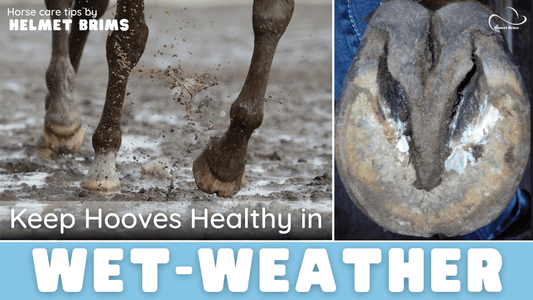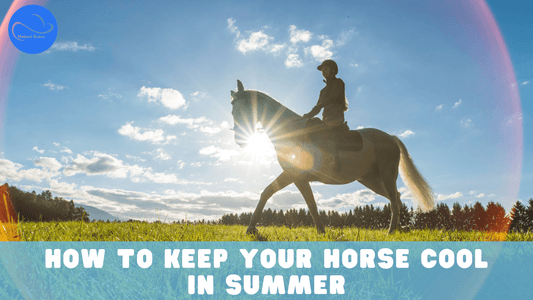UV Protection While Horse Riding: Why Cloudy Days Won't Protect Your Skin
Share
Think clouds keep you safe while riding? Think again. Whether you’re hacking through Queensland paddocks or cantering in California, UV rays still reach your skin, even through heavy cloud cover. For horse riders everywhere, understanding UV protection isn’t just a summer concern; it’s essential all year round.
UV Rays are Dangerous, and you can't see them!
Up to 80% of UV rays penetrate clouds, making overcast days deceptively risky. When you're focused on perfecting that dressage test or trail ride, sun damage is the last thing on your mind, but here’s why you shouldn’t ignore it:
- UV rays bounce off sand, water, and arena surfaces, doubling exposure.
- Even in winter, UV radiation remains strong.
- Cloud cover creates a false sense of safety that leads to overexposure.

🐎 Why Horse Riders Face Higher Risks
Riders spend long hours outdoors, often during peak UV times. Here’s what adds to the danger:
- Elevated height on horseback = more direct sunlight
- Reflection from surfaces intensifies UV impact
- Sweat reduces sunscreen effectiveness
- Regular routines mean daily exposure
Here's what one of our customers said;
"Second time I've bought one. I only bought a new one because I got a new helmet and I wanted the colour trim to match. The old one is still as good as the day I bought it over 5 years ago, and still stuck to my helmet. I didn't realise how much I missed it till I got my new one stuck on my new helmet - so much cooler riding the Queensland summer. It's also extremely handy for keeping spider webs, stray branches, etc out of my face - just look down and keep on going :-)"
— Monique H., Verified Customer, Australia
🧴 Essential Sun-Safe Tips for Every Rider
1. Daily protection:
- Apply SPF 30+ sunscreen every ride, even on cloudy days.
- Reapply every two hours or after sweating.
- Don’t skip ears, neck, or under the chin strap.
2. Ride smarter:
- When possible, avoid 10 a.m.–4 p.m.
- Remember - UV levels stay high year-round.
3. Gear up:
- Use a Helmet Brim for full-face and neck coverage.
- Choose UV-protective riding shirts and gloves.
- Add wraparound sunglasses to shield your eyes.
The Science Behind UV Exposure
According to the World Health Organisation, UV intensity increases by 4% for every 300 metres of altitude. That means high-country riders are especially vulnerable.
UV rays reach you in three ways:
- Direct radiation from the sun
- Scattered radiation through clouds and haze
- Reflected radiation from sand, water, or arena surfaces
Seasonal Considerations for International Riders
Australia & New Zealand (Southern Hemisphere)
- Cool winter temps don’t reduce UV strength — it’s strong all year.
- Clear skies around midday can mean peak exposure even in cooler months.
United States & Canada (Northern Hemisphere)
- UV levels climb from April through September, with long daylight hours in summer.
- Desert states, mountain regions, and coastal areas all face high UV reflection.
- Heat and humidity can reduce sunscreen effectiveness, so reapply often.
United Kingdom & Europe
- Summer months (May–August) bring long riding days and rising UV risk.
- Even under cloudy skies, UV penetrates and reflects off sand arenas and grass paddocks.
South Africa
- One of the world’s highest UV zones, especially from October to March.
- Essential to use brimmed helmets and UV-rated gear year-round.
- Emerging Equestrian Regions
Argentina, Chile, and other South American nations have strong horse cultures and high sun exposure.
- Middle Eastern riders (UAE, Qatar, Oman) face desert glare and year-round UV intensity.
- Japan’s growing riding community also benefits from consistent sun protection in all seasons.
🗓 Your Year-Round Protection Plan
- Layer your defences:
- Apply quality broad-spectrum sunscreen.
- Wear UV-protective clothing and gloves.
- Add a properly fitted Helmet Brim.
- Check the daily UV index before every ride.
- Schedule regular skin checks.
💬 Q&As
Q: Do UV rays still reach me when it’s cloudy?
Yes. Up to 80 percent of UV radiation passes through clouds, which is why cloudy rides can still cause sun damage.
Q: What’s the best sun protection for horse riders?
Use layered protection: sunscreen, UV-protective clothing, and a Helmet Brim that shades your face and neck.
Q: Are Helmet Brims suitable for windy conditions?
Absolutely. Each brim has a stiff internal wire that holds its shape and prevents it from flying up, even in strong wind.
🛍 Take Action Today
Don’t wait for a sunburn to remind you. Thousands of riders already trust Helmet Brims, the only brim proven to stay secure in high wind and intense Aussie sun.
Protect your skin, ride with confidence, and make every outing a safe one.
👉 Shop Helmet Brims now




